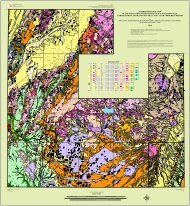Wetlands in northern Salt Lake Valley, Salt Lake County, Utah
Wetlands in northern Salt Lake Valley, Salt Lake County, Utah
Wetlands in northern Salt Lake Valley, Salt Lake County, Utah
Create successful ePaper yourself
Turn your PDF publications into a flip-book with our unique Google optimized e-Paper software.
<strong>Wetlands</strong> <strong>in</strong> Northern <strong>Salt</strong> <strong>Lake</strong> <strong>Valley</strong>, <strong>Salt</strong> <strong>Lake</strong> <strong>County</strong>, <strong>Utah</strong>—an evaluation of the threats posed by ground-water developement and drought 5MethodsWe <strong>in</strong>stalled 12 shallow monitor<strong>in</strong>g wells <strong>in</strong> three wetlandareas near Great <strong>Salt</strong> <strong>Lake</strong> (figure 1 and appendix C). Twowells were sampled for water quality, and ground-water depthwas measured <strong>in</strong> n<strong>in</strong>e of the wells (three wells did not yieldwater). The wells were manually <strong>in</strong>stalled us<strong>in</strong>g a hand augerto bore a hole <strong>in</strong>to the ground to a depth of 3 to 7 feet (1–2 m),and then <strong>in</strong>sert<strong>in</strong>g one-<strong>in</strong>ch-diameter slotted PVC and backfill<strong>in</strong>gthe void between the borehole and PVC with the handaugercutt<strong>in</strong>gs. We mapped the well locations us<strong>in</strong>g a TrimbleTotal Station GPS system hav<strong>in</strong>g sub-centimeter vertical andhorizontal accuracy. Water levels <strong>in</strong> the wells were measuredmanually dur<strong>in</strong>g the spr<strong>in</strong>g and summer of 2008. The two water-qualitymonitor<strong>in</strong>g wells were sampled <strong>in</strong> May 2008, andthe samples were analyzed at the <strong>Utah</strong> Division of Epidemiologyand Laboratory Services for general chemistry, dissolvedmetals, nutrients, and total organic carbon. Computer model<strong>in</strong>gwas conducted dur<strong>in</strong>g 2007 and 2008.Previous StudiesRichardson (1906) conducted the first <strong>in</strong>vestigation of groundwaterconditions <strong>in</strong> <strong>Salt</strong> <strong>Lake</strong> <strong>Valley</strong> (previously known asJordan <strong>Valley</strong>); that study, which <strong>in</strong>cluded <strong>Utah</strong> <strong>Valley</strong>, producedmaps show<strong>in</strong>g depth to ground water and areas offlow<strong>in</strong>g wells. Taylor and Leggette (1949) conducted a morethorough <strong>in</strong>vestigation that <strong>in</strong>cluded many well records, anddiscussions of ground-water occurrence, recharge and discharge,and chemical quality. Lofgren (1952) discussed thestatus of ground-water development <strong>in</strong> <strong>Salt</strong> <strong>Lake</strong> <strong>Valley</strong> as of1951. Marsell (1964) discussed water-supply issues as part ofa comprehensive review of the geology of <strong>Salt</strong> <strong>Lake</strong> <strong>County</strong>.Mar<strong>in</strong>e and Price (1964) updated previous studies and subdividedthe valley <strong>in</strong>to ground-water districts for water-resourcemanagement purposes. Hely and others (1967, 1968, 1969)compiled hydrologic and climatalogic data that were used toproduce a summary of ground-water hydrology <strong>in</strong> <strong>Salt</strong> <strong>Lake</strong><strong>Valley</strong> (Mower, 1969a) and water resources <strong>in</strong> <strong>Salt</strong> <strong>Lake</strong><strong>County</strong> (Hely and others, 1971). Arnow and Mattick (1968)evaluated the thickness of bas<strong>in</strong>-fill deposits. Mower (1968)discussed ground-water discharge toward Great <strong>Salt</strong> <strong>Lake</strong> <strong>in</strong>bas<strong>in</strong>-fill deposits. Mower (1969b) discussed ground-water<strong>in</strong>flow through channel fill <strong>in</strong> seven Wasatch Range canyons<strong>in</strong> <strong>Salt</strong> <strong>Lake</strong> <strong>County</strong>. Arnow and others (1970) used waterwelllogs to del<strong>in</strong>eate the pre-Quaternary surface <strong>in</strong> <strong>Salt</strong> <strong>Lake</strong><strong>Valley</strong> to be used as a general guide for water-well drill<strong>in</strong>g.Mower (1970) discussed ground-water recharge to <strong>Salt</strong> <strong>Lake</strong><strong>Valley</strong> from <strong>Utah</strong> <strong>Valley</strong>. Seiler and Waddell (1984) conductedan assessment of the shallow unconf<strong>in</strong>ed aquifer <strong>in</strong> <strong>Salt</strong><strong>Lake</strong> <strong>Valley</strong>. Herbert and others (1985) conducted a seepagestudy of six canals <strong>in</strong> <strong>Salt</strong> <strong>Lake</strong> <strong>County</strong>. Waddell and others(1987b) evaluated the chemical quality of ground water <strong>in</strong>the bas<strong>in</strong>-fill aquifer for the 1969–85 time period. Waddelland others (1987a) evaluated ground-water conditions <strong>in</strong> <strong>Salt</strong><strong>Lake</strong> <strong>Valley</strong> with emphasis on predicted effects of <strong>in</strong>creasedwithdrawals from wells. Thiros (1992) compiled selected hydrologicdata for <strong>Salt</strong> <strong>Lake</strong> <strong>Valley</strong> with emphasis on data fromthe shallow unconf<strong>in</strong>ed aquifer and conf<strong>in</strong><strong>in</strong>g layers. Andersonand others (1994; see also Anderson and Susong, 1995)mapped ground-water recharge and discharge areas for thepr<strong>in</strong>cipal aquifers along the Wasatch Front, <strong>in</strong>clud<strong>in</strong>g the pr<strong>in</strong>cipalaquifer <strong>in</strong> <strong>Salt</strong> <strong>Lake</strong> <strong>Valley</strong>. Thiros (1995) <strong>in</strong>vestigatedthe chemical composition and movement of ground water, andthe hydrologic properties of bas<strong>in</strong>-fill material, to better understandthe flow system <strong>in</strong> <strong>Salt</strong> <strong>Lake</strong> <strong>Valley</strong>. Lambert (1995a)produced a three-dimensional, f<strong>in</strong>ite-difference, numericalground-water flow model for the bas<strong>in</strong>-fill aquifer, which he(Lambert, 1995b) subsequently used to produce capture zonesfor selected public supply wells and simulate (Lambert, 1996)the movement of sulfate <strong>in</strong> ground water. Waddell and others(2004) assessed water quality <strong>in</strong> the Great <strong>Salt</strong> <strong>Lake</strong> bas<strong>in</strong>s, <strong>in</strong>clud<strong>in</strong>g<strong>Salt</strong> <strong>Lake</strong> <strong>Valley</strong>. Burden and others (2005) describedchanges <strong>in</strong> ground-water conditions <strong>in</strong> <strong>Utah</strong>, <strong>in</strong>clud<strong>in</strong>g <strong>Salt</strong><strong>Lake</strong> <strong>Valley</strong>, from 1975 to 2005. Lowe and others (2005) andLowe and Wallace (2006) mapped ground-water sensitivityand vulnerability to pesticides for the <strong>Salt</strong> <strong>Lake</strong> <strong>Valley</strong> bas<strong>in</strong>fillaquifer. Wallace and Lowe (2009) mapped ground-waterquality classes for the <strong>Salt</strong> <strong>Lake</strong> <strong>Valley</strong> bas<strong>in</strong>-fill aquifer.SETTINGPhysiography<strong>Salt</strong> <strong>Lake</strong> <strong>Valley</strong> is a north-south-trend<strong>in</strong>g valley located <strong>in</strong>north-central <strong>Utah</strong> southeast of Great <strong>Salt</strong> <strong>Lake</strong>. <strong>Salt</strong> <strong>Lake</strong><strong>Valley</strong> is <strong>in</strong> the <strong>Salt</strong> <strong>Lake</strong> <strong>Valley</strong> segment of the Wasatch Front<strong>Valley</strong>s section of the Great Bas<strong>in</strong> physiographic prov<strong>in</strong>ce(Stokes, 1977). The valley is bounded on the east and northeastby the central portion of the Wasatch Range, on the northwestby Great <strong>Salt</strong> <strong>Lake</strong>, on the west by the Oquirrh Mounta<strong>in</strong>s,and on the south by the Traverse Mounta<strong>in</strong>s. Elevationsrange from about 4200 feet (1280 m) <strong>in</strong> the lowest part of thevalley near Great <strong>Salt</strong> <strong>Lake</strong> to more than 7000 feet (2130 m)<strong>in</strong> the Traverse Mounta<strong>in</strong>s, 9000 feet (2740 m) <strong>in</strong> the OquirrhMounta<strong>in</strong>s, and 11,000 feet (3350 m) <strong>in</strong> the Wasatch Range.<strong>Salt</strong> <strong>Lake</strong> <strong>Valley</strong> has also been referred to as Jordan <strong>Valley</strong> becauseof the Jordan River, which flows northward <strong>in</strong>to the valleythrough the Jordan Narrows, a water gap <strong>in</strong> the TraverseMounta<strong>in</strong>s, and ultimately <strong>in</strong>to Great <strong>Salt</strong> <strong>Lake</strong>. Six othermajor streams flow <strong>in</strong>to the valley from the Wasatch Rangeto the east and <strong>in</strong>to the Jordan River; these streams are ma<strong>in</strong>lyfed by snowmelt dur<strong>in</strong>g the spr<strong>in</strong>g and early summer. M<strong>in</strong>oramounts of water enter the valley from the Oquirrh Mounta<strong>in</strong>s.The mounta<strong>in</strong>s that surround <strong>Salt</strong> <strong>Lake</strong> <strong>Valley</strong> are composedof rocks that range <strong>in</strong> age from Precambrian to Tertiary. TheWasatch Range consists of Precambrian, Paleozoic, Mesozoic,and Cenozoic sedimentary and metasedimentary rocks thathave been <strong>in</strong>truded by Tertiary granitic and dioritic stocks.
















